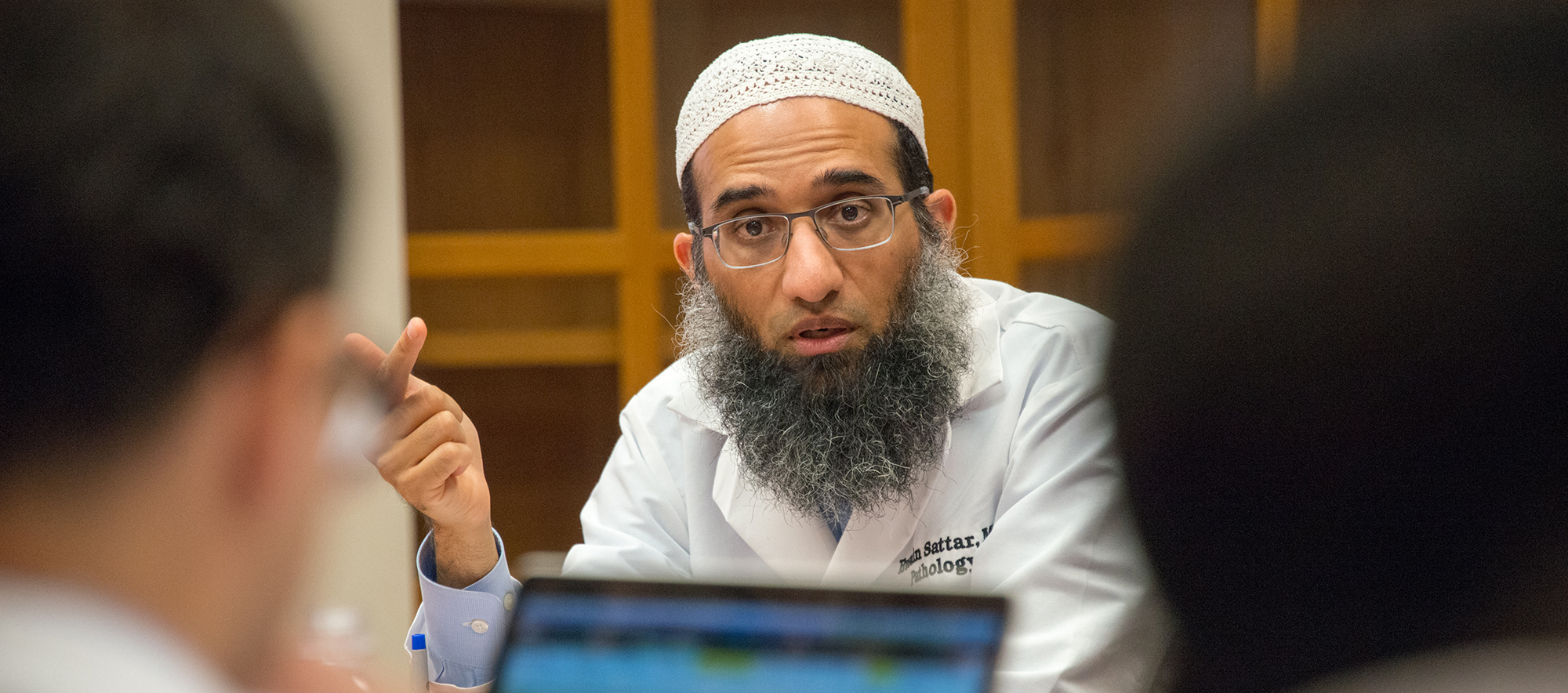
UChicago Medicine pathologist Husain Sattar, AB’93, MD’01, created Pathoma, a pathology review course used by medical students around the world. (Photography by Joe Sterbenc)
Husain Sattar, AB’93, MD’01, is an unlikely celebrity in medical education.
In 1996 Husain Sattar, AB’93, MD’01, took a leave of absence from the Pritzker School of Medicine to study Arabic and Islamic spirituality in Islamabad, Pakistan. He spent his days in a clay-walled classroom that would reach 120 degrees in the summer and freeze in the winter.
Though creature comforts were lacking, the experience was transformative. While in Islamabad, Sattar studied under a teacher whose skill and charisma made a lasting impression; nearly 20 years later, when Sattar began work on Pathoma, his hugely popular online pathology course, the smiling, gray-bearded instructor was his model.
The man lectured passionately, as if there were 3,000 people in the room instead of eight, but what the young American medical student found most impressive was his skill at distilling colossal quantities of material. “He had this ability to take vast amounts of information and summarize it in the most eloquent, simple, principle-based method,” Sattar says.
Today that’s what thousands of medical students say about Sattar. “He has a remarkable gift for clarity,” says Palmer Greene, a third-year Pritzker student. “He can take the pathophysiology of any organ system and present the information in a way that makes the entire mechanism click in your head.”
It took Sattar years to get to that point. After two and a half years abroad, he returned to Chicago to start his final year of medical school, worried that he’d forgotten everything he knew about medicine. Each night he focused on what he needed to understand to get through the next day.
He began to realize he had been memorizing details but missing the big picture. For example, grasping the pathology of the different anemias was challenging until he got back to basics. A red blood cell, he reminded himself, is “just a ball full of hemoglobin”—an oxygen-carrying protein—“with a membrane around it.” And if you understand the biochemistry of hemoglobin, you can understand anemia.
At the same time Sattar was reorganizing his understanding of medicine, he was also preparing for the next stage of his career. He completed a pathology rotation and decided he liked the specialty because it afforded him time for reflection. “I’m someone who needs to digest something before I can feel comfortable with it,” he said. “Pathology sort of lent itself to that.”
Sattar completed his residency at the University of Chicago Medicine, eventually joining the faculty as a surgical pathologist specializing in breast pathology. He is associate director of Clinical Pathophysiology and Therapeutics, a second-year course at Pritzker, and has earned a number of teaching honors.
In 2010 Satttar decided to combine the techniques of his Pakistani teacher with his own hard-won pathology knowledge. He asked dean Holly Humphrey, MD’83, if he could teach an elective course for Pritzker students preparing for their medical licensing exams.
“I was teaching it the way I felt pathology should be taught, just me sitting and chatting with the students, no notes, nothing,” he says. “Just me talking about how I think about different principles of pathology and how I tie different basic science principles in with disease states. It’s about memorizing less and understanding more.”
Encouraged by the experience, he began work on Fundamentals of Pathology (Pathoma, 2011), a textbook, plus video lectures recorded in his basement late at night and other online materials.
Nine months later, he published the book and videos. No one bought them.
“I was so sad. … I did everything on my own—to the extent of sampling the paper stock—because I wanted this to be exactly my vision,” he says. To boost awareness of the Pathoma materials, a student suggested that Sattar give sample lectures at other medical schools.
It worked: since 2011, Sattar’s do-it-yourself videos have been viewed more than six million times. Students from all over the country and the world praise Pathoma on message boards, blogs, and in social media. Occasionally, the adulation verges on cultish. A wholly unlicensed “Husain Sattar is my homeboy” online apparel store unaffiliated with Pathoma sells T-shirts, mugs, and water bottles emblazoned with Sattar’s faculty picture.
So why do students love Pathoma? There’s Sattar’s serene speaking style (he has a “calming presence in the midst of a year when everyone is stressing out,” Greene says), and his simple diagrams (some students joke that a stick figure would be complex for Sattar). He uses a two-by-two grid to describe the functioning of the heart, “and I never stopped thinking about it that way,” says Lucy Rubin, a student at Tufts University Medical School.
Now that Pathoma is so popular, medical publishers have flocked to Sattar’s office, eager to learn what he did. Sattar is proud he was able to illustrate a new way of teaching medical concepts. “I think the fact that it got big so quickly shows there’s a real deep need for something like this. Others are now picking up on that, and that’s great. We need to advance medical education as much as we can.”
